The Top Octave Pedals – Perfect Candidates for Your Pedalboard
We may also earn commissions on purchases from other retail websites.
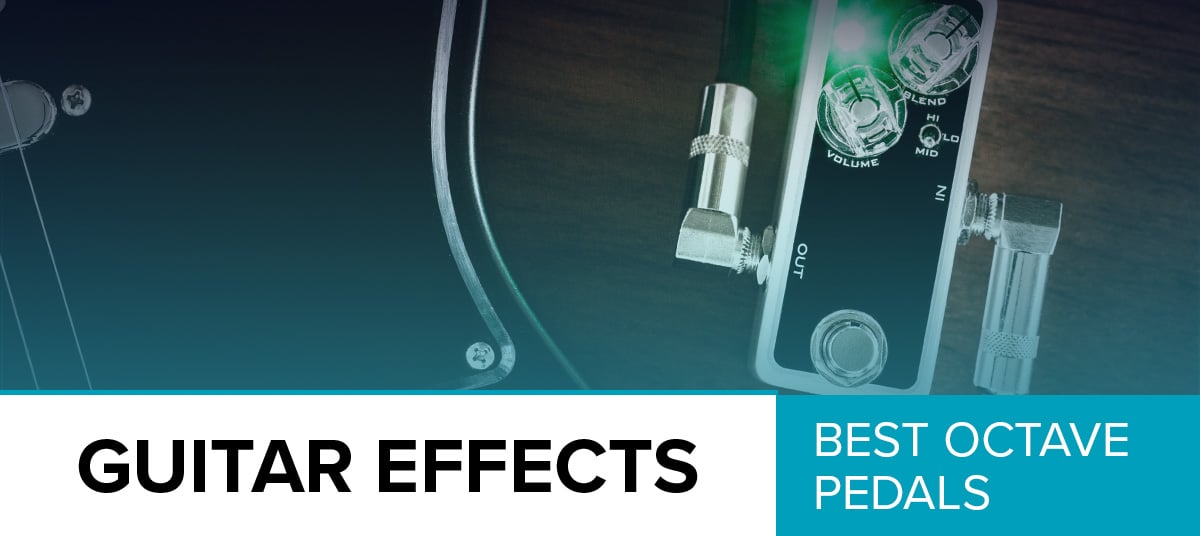
Last Updated November 19, 2019
Modulation effects have introduced a level of tone control that was nearly impossible to image several decades ago. These days you can do just about anything that you can think of with your guitar's signal. While they are heavily used, in reality modulation effects can be divided into those which get to see stage time almost every day, and those which are not used as often. Octave pedals fall somewhere in the middle. This is a pretty niche effect that is practical in very specific situations. Even though it doesn't get much game time, an octave pedal is one of the most powerful tools you can put on your pedalboard.
This single pedal can make all the difference in the world if it's used correctly, in situations that can benefit from it. The task of the octave pedal is to add a pitch shifted copy of your signal on top of the source. Some will give you one or more octaves up, while some will go both up and down.As you can imagine, these can be either very simple or very complex. It all depends on what you need and what kind of model you're interested in. Compared to other modulation pedals such as the tremolo, octaves are similar but also very different. We've selected eight awesome octave pedals that are currently considered to be the best on the market. Any one of these pedals will get the job done in its own specific way. With that said, let's jump right in.
Top 8 Best Octave Effect Pedals:
| Image | Guitar Pedal / Rating | Summary | Check Price |
|---|---|---|---|
+ -  | Electro-Harmonix Pitch Fork Total of 4.92/5 | Durable package that packs one of the best octave effects currently available. | |
+ -  | Electro Harmonix Micro POG Polyphonic Octave Total of 4.85/5 | Polyphonic octave effect pedal brought to a whole new level of excellence. | |
+ -  | DigiTech Whammy v-01 Total of 4.95/5 | One of the most iconic pedals ever, featuring a great octave function. | |
+ -  | Mooer Tender Octaver Total of 4.53/5 | Simple octave pedal that brings a solid and consistent performance every time. | |
+ -  | Boss OC-3 Dual Super Octave Total of 4.88/5 | One of the most versatile octave stompboxes with a reasonable price tag. | |
+ -  | EarthQuaker Devices Tentacle Analog Octave Up Effects Pedal Total of 4.38/5 | Simple design that brings quality tone to those who like old-school tone. | |
+ -  | MXR M288 Bass Octave Deluxe Total of 4.90/5 | One of the best octave solutions for bass guitars that actually works. | |
+ -  | TC Electronic Sub ‘N’ Up Octaver Pedal Total of 4.95/5 | Futuristic octave pedal packed with awesome features, all while being reasonably priced. |
Electro-Harmonix Pitch Fork
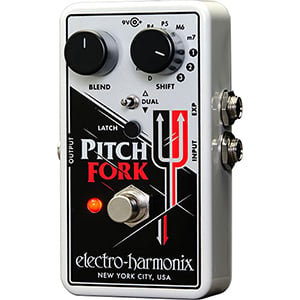
| Controls: |  |
| Features: |  |
| Performance: |  |
| Value: |  |
Electro Harmonix brings the heat with what is considered to be one of the several top tier octave pedals available today. Its plain design hides a very versatile circuitry which allows you to shift the pitch in five different ways, including Up, Down, Up and Down, as well as several transposition intervals.
You have three octaves available in both directions, which is more than enough to create some pretty awesome effects once you kick this thing into high gear. The EC Pitch Folk also comes with the latch feature, which allows you to activate the pedal like you would any regular stomp box, while you can also switch modes and activate the pedal as long as your foot is pressing the footswitch.
There are more complex pedals than this one on the market, however you will rarely find such a combination of build quality, reliability and pure performance anywhere else. It is by far one of the best guitar effects pedals ever made.
Electro Harmonix Micro POG Polyphonic Octave
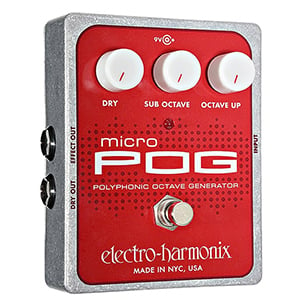
| Controls: |  |
| Features: |  |
| Performance: |  |
| Value: |  |
Second place is reserved for another Electro-Harmonix octave pedal, only this time it’s a polyphonic unit that is designed to give your guitar tone a whole lot of girth. The easiest way to describe the effect of this type of octave pedals is to imagine that you just got another six strings on your guitar.
Depending on how you decide to use it, you can make some pretty interesting results. One of the best features about the Micro POG is its super fast tracking. This polyphonic octave pedal will keep up with you no matter how fast you decide to go.
You might say it’s not a standard octave pedal, but Micro POG is capable of acting as one, although with slightly limited capability. With that said, if you decide to use it for its intended purpose, you will be graced with one of the best polyphonic octave pedals in the world. It is simply that good.
DigiTech Whammy v-01
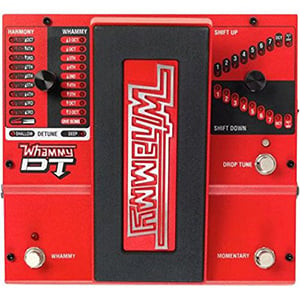
| Controls: |  |
| Features: |  |
| Performance: |  |
| Value: |  |
Unlike most brands in the industry, DigiTech decided to make an ultimate pitch shifter pedal that offers several pitch-related effects in one unit. The most significant difference between this bad boy and the rest of the pedals in this category has got to be that large expression pedal.
Even though its main purpose is to be used with the whammy portion of the effects offered, it can still be used with the octave effect. When it comes to the selection options, the fifth generation of Digitech Whammy has got you covered with a wide range of available solutions. This pedal is so effective that it was used on more than 60 Grammy awarded albums throughout its long life.
That is definitely not something a lot of brands can say about their pedals., especially niche modulation units such as this one. Whether or not this DigiTech is an overkill for an average guitar player depends on how hung up that person is on using tremolo and other modulation effects. If they do use a lot of these, then Whammy is a pretty logical choice that shouldn’t be overlooked.
Mooer Tender Octaver
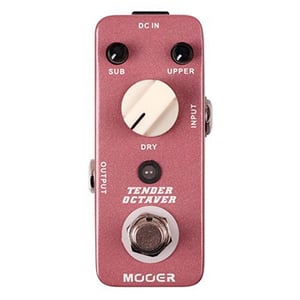
| Controls: |  |
| Features: |  |
| Performance: |  |
| Value: |  |
Now that we have gotten to know some of the more complex units on the market, it is time to familiarize ourselves with a very simple octave pedal that brings the core performance and not much more. Mooer Tender Octaver is a very sleek and compact octave pedal that gives you one octave up and one octave below the source signal.
In terms of controls, you are looking at three knobs. The largest one, labeled Dry, controls the dry sound level. Next is the Upper knob which is there to control the volume of the upper octave. Finally there’s the Sub knob, which is used to adjust the volume of the lower octave.
As you can see, it’s a meat and potatoes type of octave pedal, but the performance it offers makes up for whatever advanced features it is lacking. For the most part, the pedal was designed to accommodate those who appreciate stealthy stompboxes, or simply have a crowded pedalboard already.
Boss OC-3 Dual Super Octave
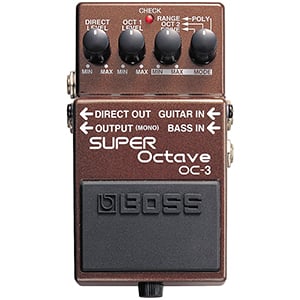
| Controls: |  |
| Features: |  |
| Performance: |  |
| Value: |  |
As one would expect, Boss has to have a model of their own that is usually packed full of interesting features. Their OC-3 Dual Super Octave is among the most popular pedals of this type at the moment. It comes in that standard Boss enclosure we are so well used to by now, only this time the color of choice is dark copper.
In terms of features, Boss decided to offer a range of two octaves, both of which go down. Aside from that, you have a knob which allows you to push the pedal into a polyphonic mode, activate the second octave, or add distortion to the octave layer. It’s not a standard octave pedal, that’s for sure.
However, it is by far one of the most practical ones as long as you don’t start playing too many notes at the same time. One more feature that we have to mention is the separate input for bass guitar. This is essentially a full spectrum octave pedal that covers just about any type of application imaginable. Having that type of power under your feet is truly something special.
EarthQuaker Devices Tentacle Analog Octave Up Effects Pedal
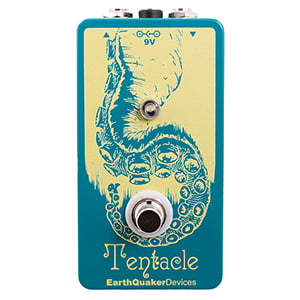
| Controls: |  |
| Features: |  |
| Performance: |  |
| Value: |  |
Now that we have gone through all of the commercial models that are dominating the scene, it’s time to turn around and look at some of the boutique variety. EarthQuaker Devices Tentacle is a very, very simple octave pedal. It offers only one octave up.
This might sound like a rather underwhelming package, but you need to keep in mind that this pedal was meant to be used the way octave pedals were originally used – in combination with a good fuzz pedal. Since it’s analog, Tentacle brings a lot more fidelity and sensitivity to your selection of pickups, tone setup and more. It’s a very versatile model despite it being controlled by a single footswitch and not much more.
This simple design is exactly what turned a lot of users away from it, but those are mostly people who either don’t know how to use this pedal correctly, or those who are simply obsessed with having the flexibility that is usually found in most modern designs.
MXR M288 Bass Octave Deluxe
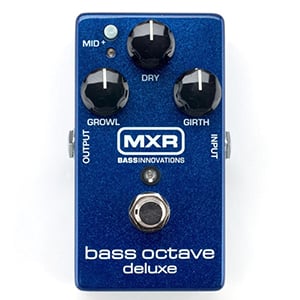
| Controls: |  |
| Features: |  |
| Performance: |  |
| Value: |  |
By default, octave pedals are reserved for guitar players. However, bass players also like to enjoy this interesting modulation effect, and that is why there’s a whole line of pedal dedicated to bass guitar. One of the best units you can get is the MXR M288 Bass Octave Deluxe.
Simple, reliable and consistent are just some of the words you can use to describe this pedal. There are three control knobs on the top panel of the MXR M288. In the middle you will find the Dry knob combines your raw signal with the octave effect.
It also adds a bit of mid range boost to the tone. Growl and girth knobs are there to control the mid range and low end response. Playing around with this pedal can definitely yield some interesting results. That’s for sure.
TC Electronic Sub ‘N’ Up Octaver Pedal
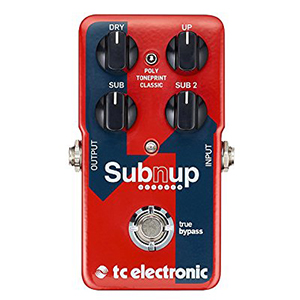
| Controls: |  |
| Features: |  |
| Performance: |  |
| Value: |  |
Last but not the least, we have a very special pedal to show you. This is some true futuristic stuff right here. TC Electronic Sub ‘N’ Up Octaver Pedal comes with several different modes of operation. You can choose to use the classic mono octaver, a polyphonic one, and finally the TonePrint octave engine.
This last mode is pure chaos. It essentially allows you to model the effect on your computer using editor software, and then upload your creation back onto the pedal. You can combine modulation with the octave, and do all kinds of crazy things in that editor.
If versatility is something you care about, this pedal is definitely something you need to check out. On top of all that, it comes with true bypass. What more can one ask for?
The Octave Effect
We have already mentioned how octave pedals work in broad terms. Now it is time to take a closer look and discuss this subject in more detail. Octave pedals used to be fairly simple analog devices. Back in those days, which weren't all that long ago, you could only count on having one octave down at your disposal. Nowadays, things have changed quite a bit. This change has to do with the development of digital technologies, which is something we are going to discuss later on.
Explaining the way octave pedals work is usually reduced to a copied signal that is pitch shifted. In reality, the signal isn't copied as much as it is synthesized by the pedal, based on the input signal. Thanks to the nature of musical instruments, it is fairly easy to synthesize an octave of a signal by halving the input frequency, or by doubling it. That is what happens in an octave pedal.The whole thing about copying the signal and pitch shifting it is more relevant to harmonizer pedals and pitch shifters. Now that we know how octave pedals work, let's see what different kinds of octavers are available, what's different about them and why they are considered to be among the best guitar effects pedals you can get.
Types Of Octave Pedals
Octave pedals are traditionally analog. When someone talks about vintage octavers, this is what they are talking about. For a long time, simple analog pedals were all that was available. Later on, with the advent of digital technologies, we have received much more versatile designs. Because of that, we can divide octave pedals into analog and digital models. Both of these offer certain benefits. One isn't necessarily better than the other. Lets take a look at the analog models first.
Analog Octave Pedals
As we have mentioned before, analog pedals are the original ones. They used analog circuitry to achieve the octave effect, and were mostly limited to one octave down compared to the input signal. Additionally, most analog octave pedals are monophonic. In other words, they are capable of tracking only single notes. The moment you play a chord, the pedal will start having issues to the point of completely failing.
Another thing to look into when dealing with analog octavers is tracking. Tracking refers to the pedal's ability to recognize which note is being played and to create the octave of said note in time. In this regard, some pedals are better than others. Overall, analog pedals are preferred when you don't need a complicated octave effect. To be completely true, analog models have a unique type of vibe which makes them popular to this day.
Digital Octave Pedals
On the other end of the ring we have digital octave pedals. These units are considerably more capable thanks to the modern electronics inside. One of the best things about digital octavers is the fact that they aren't limited to offering one octave down only. Instead, you can find models with one octave down and one octave up. Additionally, there are pedals that offer even more than that. But wait, there's more.
Digital octavers have managed to solve one of the more stubborn issues this type of guitar effect is plagued with. We are of course talking about the monophonic limit. With digital octavers, you will often run into polyphonic models which allow you to play more than one note at a time. Some have argued that such performance is simply not necessary and that octavers are still best used in monophonic mode. We will leave that discussion out of this guide because there are obviously several ways to look at it.
Lastly, there is the matter of tracking. Digital models are simply much better at tracking and offer a more reliable performance in this regard. Some even come with built in drive modes, which add distortion to the signal. Truth is that digital octavers take things to a whole new level with features and abilities.
How To Properly Use An Octave Pedal?
The next logical question that comes to mind is how to actually extract the most out of your octave pedal? There isn't really a rulebook on this, at least not with digital pedals. In all honesty, the way you are going to use your octaver comes down to how good that pedal is tracking and whether or not it supports polyphonic applications.
If we assume that you are working with a standard analog model that offers the most basic features of an octaver, your options are somewhat limited. The most popular way to use this pedal is to accentuate solos or sections where you play one note at a time. To give you a good example, lets say that you are doing a section of the song using only one string on your guitar. Adding an octave would give that section of the song quite a bit of depth. Even if the whole thing is under heavy overdrive.
As always, the best piece of advice we can give you on use of octave pedals is to experiment, and do it frequently. There is no better way to find out what your particular pedal is capable of than to push it to its limits. Especially since it doesn't really take that long to explore a more basic octave pedal.
Using Octave Pedals With Fuzz
If you talk to more experienced octave users, you will find out that these pedals are great to use with fuzz. Some say it all started with Hendrix, because he was really big on octaving his fuzz, but there are indications that fuzz/octave was a thing before that as well. Either way, combining these two effects gives you a rather awesome sound that lends itself well to solos and melodies in general. Additionally, you can achieve a similar effect if you pair an octave pedal with a distortion or an overdrive. However, it is fairly important to be conservative with the use of former as it can drown out the signal and prevent the octave pedal from properly tracking.
Conclusion
Whether or not an octave pedal is an essential part of guitarists gear is probably not even debatable. A niche group of people uses these pedals since they know exactly what having additional octaves in their tone does for their music. You can look at it this way. Octave pedals exist to do a very specific job at very specific times in a song.A lot of things has to come together in order for the octave pedal to reach its full potential. With that said, when everything aligns and you hit that octave in the right moment, the sensation is just surreal. Many guitar players are caught off guard by a quality octave pedal.
The ones we have shown you above are definitely the best picks you can go for this year. In all honesty, we don't anticipate this list to change anytime soon. Effects pedal brands have slowed down a bit, and we don't see any new octave pedals in the works. Choosing the right model depends on what you plan on doing with it, and what kind of budget you are working with. Without going into those details, one of these eight pedals is bound to get your job done just fine.




Reader Interactions